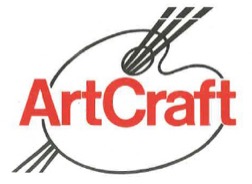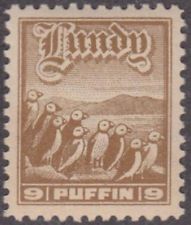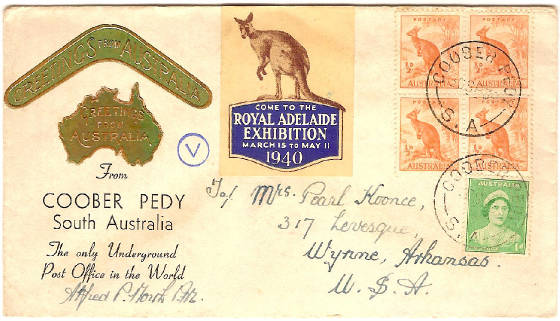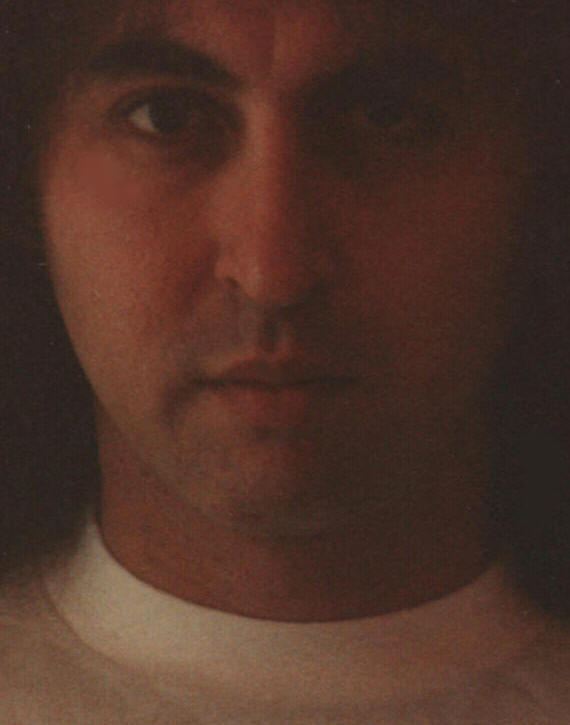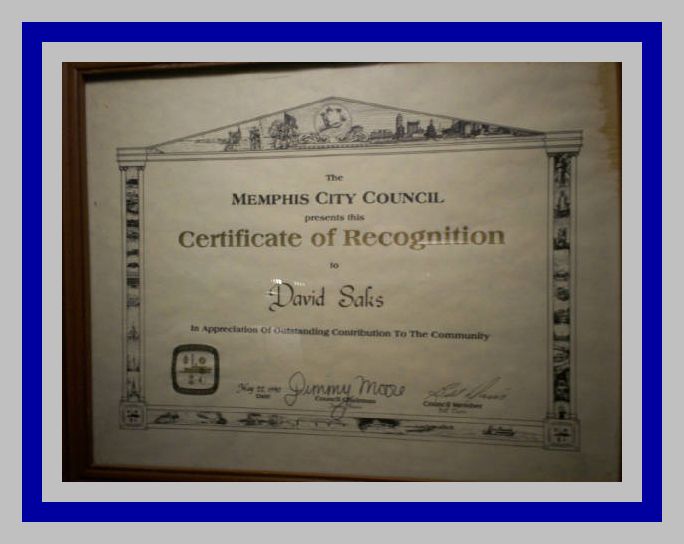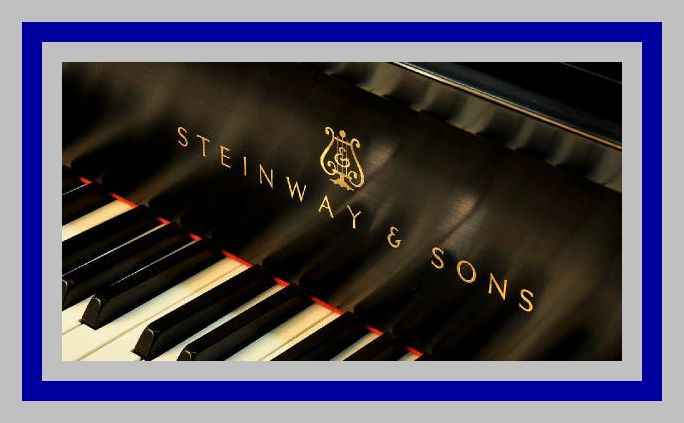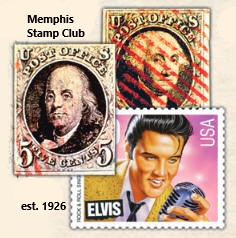|
Saturday, February 20, 2016
Electric Eye Presidential Series - The Prexies Part IIHere are four examples of the Electric Eye First Day Covers
and their stamps from my collection:1. The Left
Horizontal Electric Eye Tagged First Day Cover 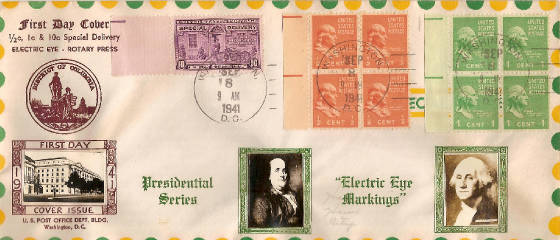
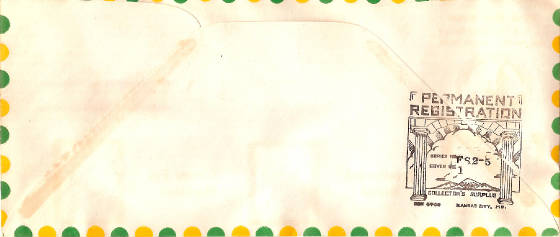

2. The Clear Electric Eye Tagged First Day Cover 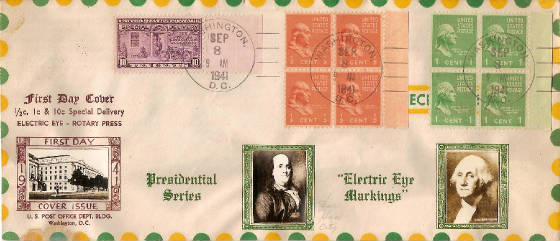
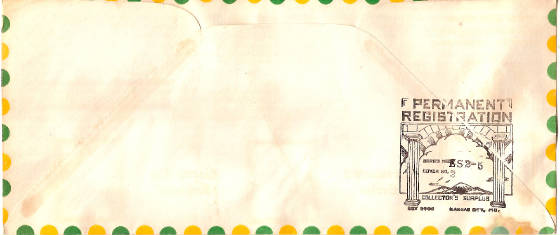

3. The Right Vertical Electric Eye Tagged First Day
Cover 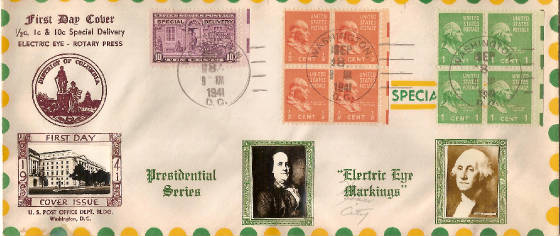
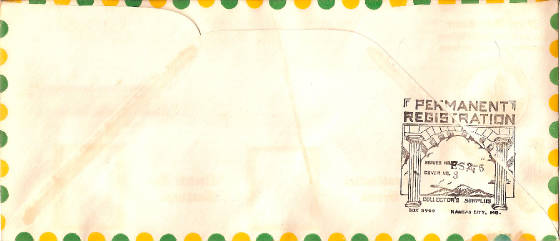

4. The Left Vertical Electric Eye Tagged First Day
Cover 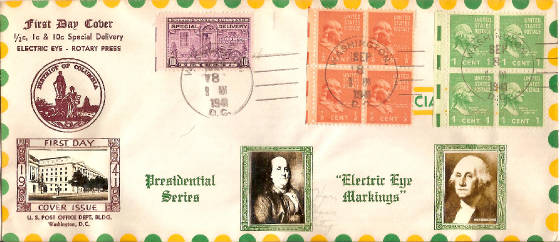
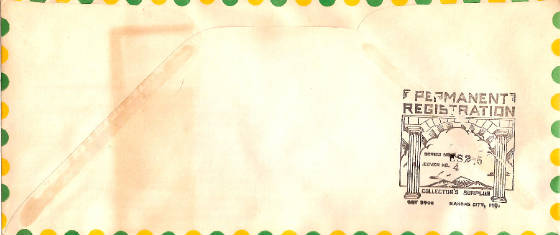

Here is an archived photo of an electric eye
stamp perforation device: 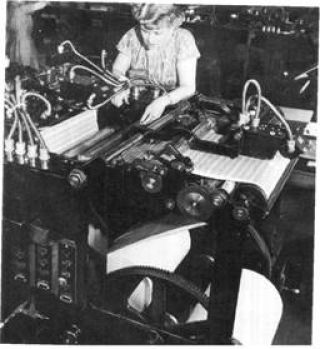
Photo by Bureau of Engraving and Printing - Electric eye perforator The tagging assisted greatly with centering the stamps for perforating. Electric eye markings are horizontal and vertical lines in the
vertical margins of stamp sheets that were used to align the perforating apparatus to keep the stamps well centered electro-optically
as they were being perforated.
These machines were the large two way Harris-Seybold perforating machines.
The Presidential Series had the markings on their selvage margins and that's how they are identified along with their
plate numbers if they them.
They had cachets on envelopes printed "electric eye" first day cover April
5, 1939.
Few are known earlier than June 3, 1938 which is the date for regular sheet stamp first day covers.
"On June 3, 1938 when the 2c Adams (Scott Catalog #806) of the Presidential Series was placed on sale, it was
found that sheets of this new value were obtainable with the Type I Electric Eye markings. The Post Office Department had
not announced this variety, as there was no difference in the stamp design. However, stamp collectors complained bitterly
and the Department promised advance notice when new types or values were placed on sale. Plates 21895, 21896, 21897, 21898
were available on the first day, however, few of the covers were mailed and are difficult to obtain." The Stamp Specialist
Emerald Book, "The Development of the Electric Eye", by Nathan Goldstein II, H.L. Lindquist Publications, 1946,
pages 87-88.
The Electric Eye was a device that employed a beam of light to facilitate more accurate perforation
of stamps during the stamp manufacturing process.The markings in the margins and gutters of sheets of stamps that enabled
the electric eye device to accomplish its purpose of more accurately perforating stamps. Stamps with electric eye markings
were first sold in 1935. Electric Eye Dashes are vertical dashes in the vertical gutter between the right and left panes that
were used by the electric eye in the perforating process. First used experimentally in 1933. Electric Eye Frame Bars are horizontal
lines in the sheet margin used by the electric eye in the perforating process.This marking was first used in 1939. The Electric
Eye Gutter Bar - horizontal line in the left sheet margin at the end of the horizontal sheet gutter was used by the electric
eye in the perforating process. This marking replaced the Electric Eye Margin Line on some plates in 1939. The Electric Eye
Margin Line - horizontal line in the right margin of a sheet at the end of the horizontal sheet gutter was used by the electric
eye in the perforating process. First used experimentally in 1933.
7:00 am cst
Friday, February 19, 2016
Electric Eye Presidential Series - The Prexies Part IThe half cent orange Franklin stamp (Scott Catalog#803)
and the one cent green (Scott Catalog#804) were both part of the 1938-1954 Presidential Issues, otherwise known as the "Prexies". The 10 cent gray violet Special Delivery stamp (Scott Catalog#E15)
was issued in 1927. They were all rotary press
printed. This is the right vertical tag First
Day of Issue "Electric Eye" "Presidential Series" September 18, 1941. 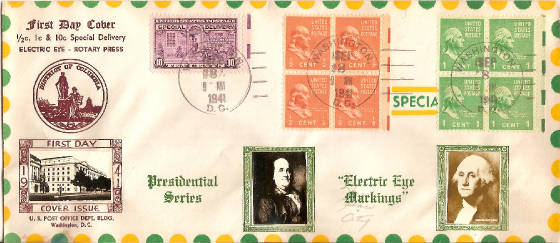
The ½¢ stamp did not pay any
existing postal rate.
It was used in multiples or in combination with other stamps and stamped envelopes
to
make up a fractional rate, typically for third class domestic mail and international printed
matter. For
the first time, a series was issued with a denomination that did not meet an existing postal need.
One cent paid the post card rate until 1952
and could also have solo use to pay the drop letter rate (for local or star route delivery). It also paid the 2nd
class (periodical) rate, the 3rd class for small items, less than 8 oz., such as printed matter or plants
and seeds and the special treaty rate with Canada. The
10 cent Special Delivery stamp was a rotary press printed stamp first issued on November 29, 1927. The design, which originated
in 1925 and was repeated for different denominations of the series, was the first to include a motorcycle on a United States
stamp. 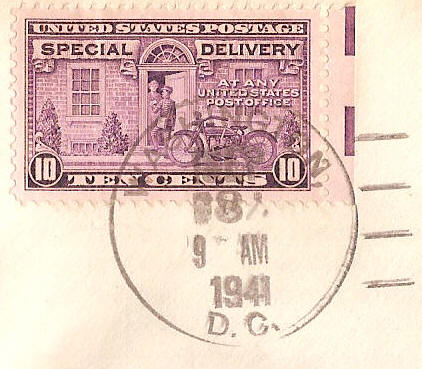

Here are some additional features of this beautiful
First Day Cover for you: 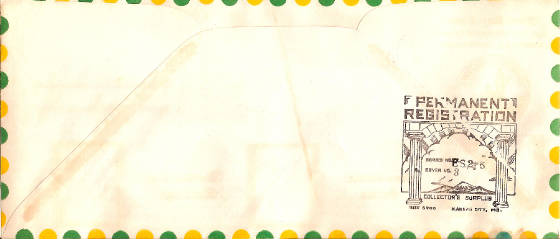
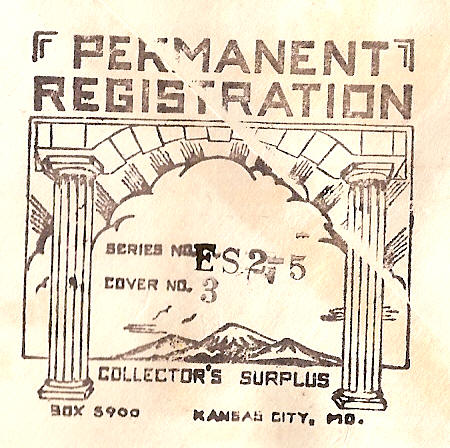
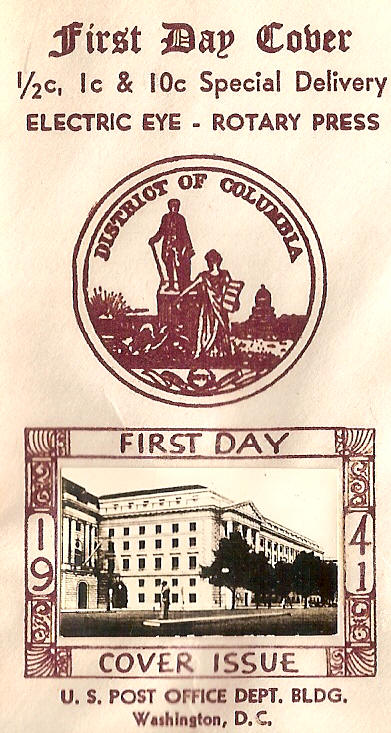
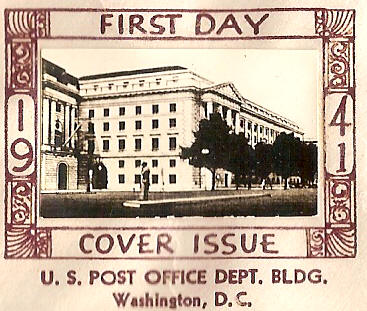
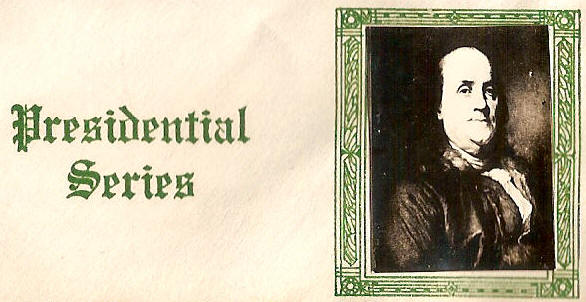
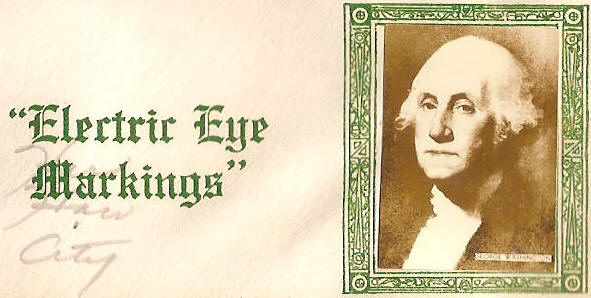
The Electric Eye Frame Bars are the vertical lines
in the left sheet margins of the stamp blocks above used by the electric eye machine during the perforating process. It was
instituted in 1939 and manufactured by the Harris Seybold Potter company for electric eye rotary press cutting. 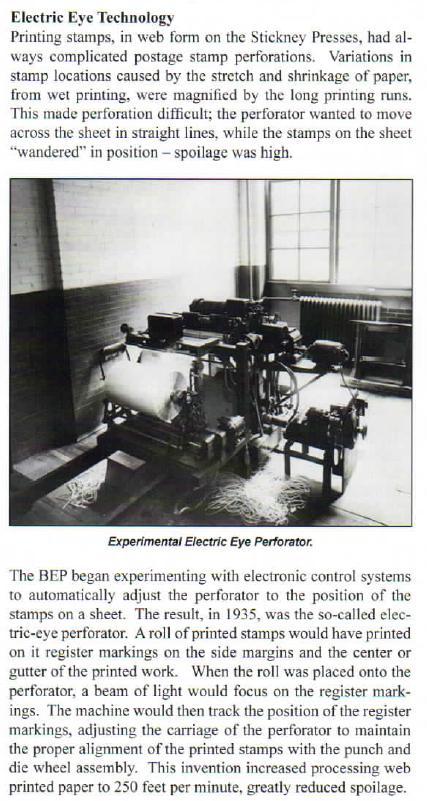
More reasons to love stamp collecting.
Thursday, February 18, 2016
The Windmills of Your MindWindmills were all over Europe by the 17th century. All
over England, France and everywhere in Holland. It's
believed that more than 8000 windmills adorned the Dutch countryside in the 1600's. They symbolized the nation. 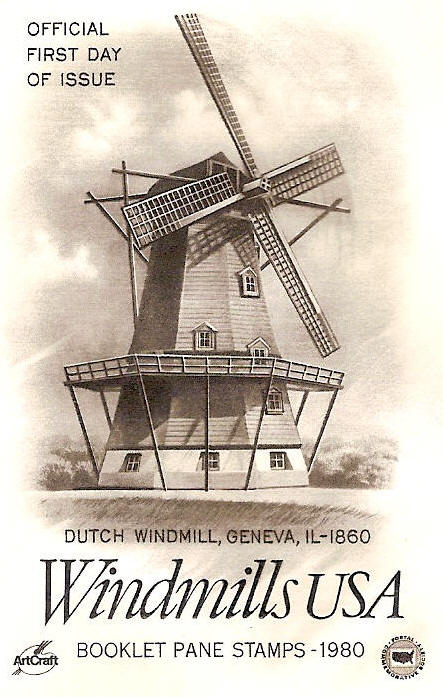
The Dutch came to the Unites States and began constructing
their windmills on Manhattan Island in the early part of the 17th century before the Revolutionary War. The windmill was constructed of brick or stone, had a wooden roof
and had a shaft that assisted in the rotation of the sails. The roof actually revolved with the shaft attached to the sails. The miller would rotate the entire cap mounted
on the roof by the movement of a special pole attached to the tail of the shaft and face the sails into the wind. Windmills were about five stories high and the sails swept an area
of approximately 80 feet in diameter. The sails could generate up to 14 horsepower of energy The top of the windmill with the cap also had controls that controlled the speed of the sails. The
miller controlled the cap from the windmill's second story. When grain was brought to the mill it was first crushed on the ground and lifted in buckets to the third story
where fans cleaned it. Then it was then sent
through shoots to grinding stones on the second story and sent back to the ground to be sifted and stored. On the average, Dutch Mills produced 20 to 40 barrels of meal a
day. 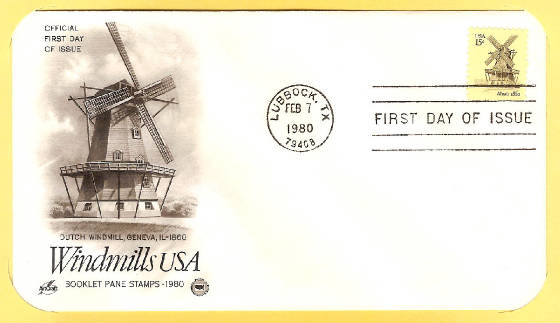
Scott Catalog #1741, design#A1130 features a Dutch
windmill in Batavia / Geneva, Illinois. The
cachet represents the windmill in Geneva, Illinois in 1860. 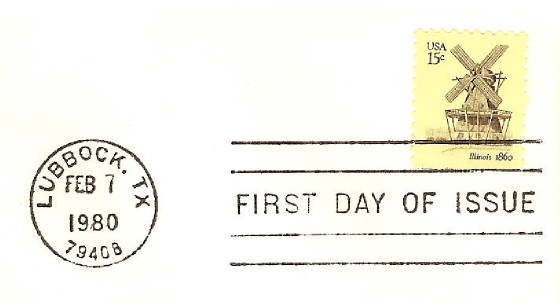
Ronald C. Sharpe designed this beautiful 15 cent booklet
stamp featuring a 19th century Dutch windmill located in the Fabyan Park Forest Preserve located in Geneva, Illinois.
The First Day of Issue ceremony was held on February 7, 1980 in
Lubbock, Texas at the site of the Texas Tech University windmill museum.
|

